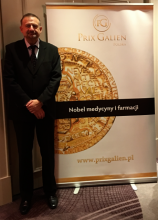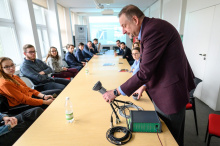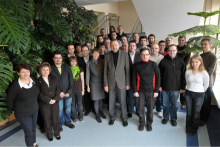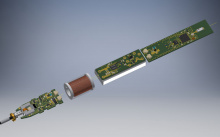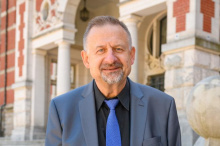Date added: 2020-10-12
Prof. Andrzej Czyżewski with the ‘Personality of the Year 2020’ award [#LudziePG]
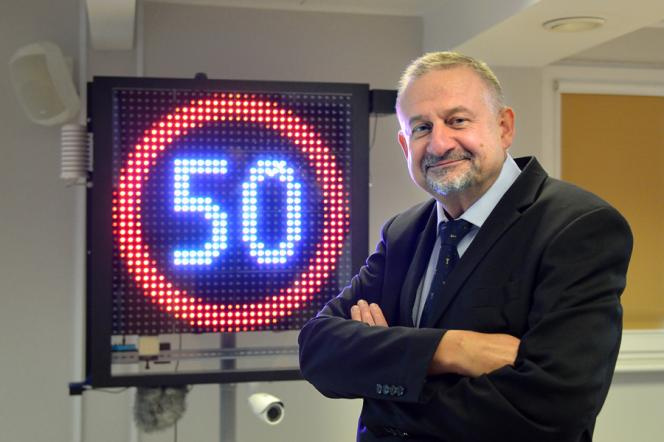
Maciej Dzwonnik, GUT spokesman: You devoted your entire professional life to Gdańsk University of Technology. You started working here right after graduation, at the age of 26. Today, young scientists often choose a different career path.
Prof. Andrzej Czyżewski: Indeed, yet after almost 40 years of work at our university, I think that I would not change anything on this path. In my opinion, the stability of employment and continuity of work is a big advantage that allows you to build a workshop tailored to your abilities and competences. This usually translates into effective scientific and research activity.
In my case, an enthusiast of modern technologies since childhood, this path turned out to be the right one. Young scientists should remember that work in the private sector is often limited by the direction of development chosen by a given company or enterprise. On the other hand, academic work gives you much more scientific freedom, and if you do what you are interested in every day, work does not tire you out, but gives you satisfaction.
Have you always wanted to become a scientist?
–Already as a teenager, I had a passion for technical sciences and I dealt with similar issues that I later raised in my professional work. When I was 12-13 I was building my first electronic devices, and a few years later even my own recording studio in my basement. I was already studying at Gdańsk University of Technology, and I made most of the equipment with my own hands, based on old and unnecessary equipment in university warehouses. It turned out so well that for some time, together with my friends from the university, I ran student programs for Polish Radio as part of the popular ‘Summer with Radio’ series. I have very fond memories of this episode.
After such beginnings, it is difficult to imagine any other direction than sound engineering.
–It's true, but when I started my studies at GUT, I was very lucky to find great mentors, i.e. PhD, Eng. Gustaw Budzyński and PhD, Eng. Marianna Sankiewicz. Immediately after the defense of my thesis, I found a place in the Institute of Sound Engineering created and managed by them. First, I became an assistant there, and in 1992, when PhD, Eng. Budzyński retired, he handed over the management of this institute to me. With the passage of subsequent years and the development of research interests in other areas, including in the field of electronics, telecommunications, computer science and medical technologies, it was transformed into the Department of Sound Engineering, then into the Department of Sound and Image, and then into the Department of Multimedia Systems, which is still functioning today.
\You often emphasize that, instead of yourself, you prefer to talk about your work and your team's work, your technologies and inventions. So let's talk about them. Which of your inventions was particularly important to you?
–It is difficult to choose the most important one. It was not uncommon for individual research projects within our department to be a continuation or extension of the scope of research initiated earlier. However, they all have one common denominator - we conduct them with the intention of implementing them for general use, most often based on agreements with large external partners and international corporations.An example of such activities is, for example, the IDENT project, i.e. a multimodal, biometric system for verifying the identity of a bank customer, which we implemented in partnership with PKO BP, the largest bank in Poland, and with the participation of the Gdańsk-based Microsoft company. The system allows for automatic identification and authentication of a given person's identity based on the arrangement of blood vessels in the hand, face shape, voice or a signature made with a special biometric pen. In other words, a bank client can be recognized in a bank branch without even having an identity document with him/her, and it will be much more difficult to impersonate such a client. We are currently working on another project that should further expand the possibilities of biometric identity authentication.
When testing this system, PKO Bank Polski installed over 100 biometric stations in its branches. How did the bank's customers approach this method of verification?
–Actually the reception was very positive. Participation was voluntary, yet we collected a very wide range of material for further research, i.e. approximately 200 000. samples from 10 thousand customers. People are increasingly paying attention to aspects such as cybersecurity and the protection of their data, and this system can ultimately help them protect their identity and prevent fraud.
Your invention, CyberOko (CyberEye), is also well known. A few years ago, it even became the Polish invention of the year. It also won a number of other prestigious awards, including. the promotional emblem ‘Teraz Polska’ and the international medical award Prix Galien.
–This is true, but the pattern I mentioned earlier is also repeated here: individual projects and research works are often a continuation and effect of activities carried out earlier. Within our department, we have prepared, for example, a number of systems for conducting telemedicine screening of the senses used for communication, i.e. hearing, sight and speech. These activities were based on close cooperation with prof. Henryk Skarżyński, director of the Institute of Physiology and Pathology of Hearing, and the solutions we have developed together are used throughout the country and abroad. For example, over a million school-age children in Poland have been tested with the use of hearing test systems, and these solutions are used for research on five continents.
In the same field, we have managed to develop, among others apparatus supporting people who stutter, artificial larynx and speech therapy systems based on the Tomatis method, i.e. with the use of bone conduction of sounds. On the other hand, the device used to communicate with the environment by people in a coma is the just mentioned CyberEye. Based on the experience gained, we are also working on CyberBed - a ‘cyber bed’, which would help people after serious traffic accidents avoid digital exclusion.
You could say: technical science at the service of medicine.
– Even more: at the service of man. While working on CyberEye, we tried to integrate three different technologies: eye tracking, computer emission of odors and the analysis of the bioelectrical activity of the patient's brain, all in people with reduced awareness. Thanks to this, CyberEye fulfills two main tasks: it is used both in the process of diagnosing the patient and for subsequent therapy and treatment, through stimulation and the possibility for the patient to establish direct contact with the therapist or family members. I believe it is the responsibility of scientists to give such people a chance to express their feelings and thoughts.
What are you and the scientists from the Department of Multimedia Systems working on now?
–Apart from the aforementioned activities related to the CyberBed project, or the continuation of the IDENT project, we are also working on the INZNAK project, i.e. ‘intelligent’ road signs for adaptive control of vehicle traffic. When it is successfully implemented, the devices developed by us will communicate with each other in V2X technology and actively react to the traffic situation, suggesting to drivers the speed appropriate to the situation.
We are also working on a speech recognition system based on lip movements and on the interfaces connecting the human brain and the computer. Another project is a technology of non-contact monitoring of patients with suspected Covid-19 disease, developed and clinically tested together with the team of prof. Krzysztof Narkiewicz from the Medical University of Gdańsk. We are also preparing for acoustic and visual monitoring of wind turbines.
In a separate interview, I spoke with PhD Michał Kucewicz, who is an employee of your department. PhD Kucewicz talked about the mechanisms underlying the functioning of the human brain and memory, but he also talked about the development opportunities for young scientists offered by work at Gdańsk University of Technology. Are they better today than when you started your scientific career?
–In many ways, yes. What's more, our university is technical institution, so unlike many other academic centers, it can directly affect the economy. Educating students is one thing, meanwhile, one should also remember about the need to create conditions for the harmonious development of young scientists, also through active cooperation with the socio-economic environment and through the dissemination of results in reputable scientific journals. Every day I try hard to ensure that the young employees of our department do not run out of ideas for innovative scientific and technical projects, but their implementation often depends on the university's capabilities. In our case, it can be seen that these possibilities are getting better every year.
……………………
#LudziePG is a new editorial series of the Promotion Office of Gdańsk University of Technology, in which you will be able to learn about the biographies and achievements of scientists from our university who work on interesting and innovative research projects on a daily basis. Applications for the next episodes can be sent to the GUT press spokesman: maciej.dzwonnik@pg.edu.pl.


